check engine Alfa Romeo 166 2006 Owner handbook (in English)
[x] Cancel search | Manufacturer: ALFA ROMEO, Model Year: 2006, Model line: 166, Model: Alfa Romeo 166 2006Pages: 272, PDF Size: 4.17 MB
Page 141 of 272
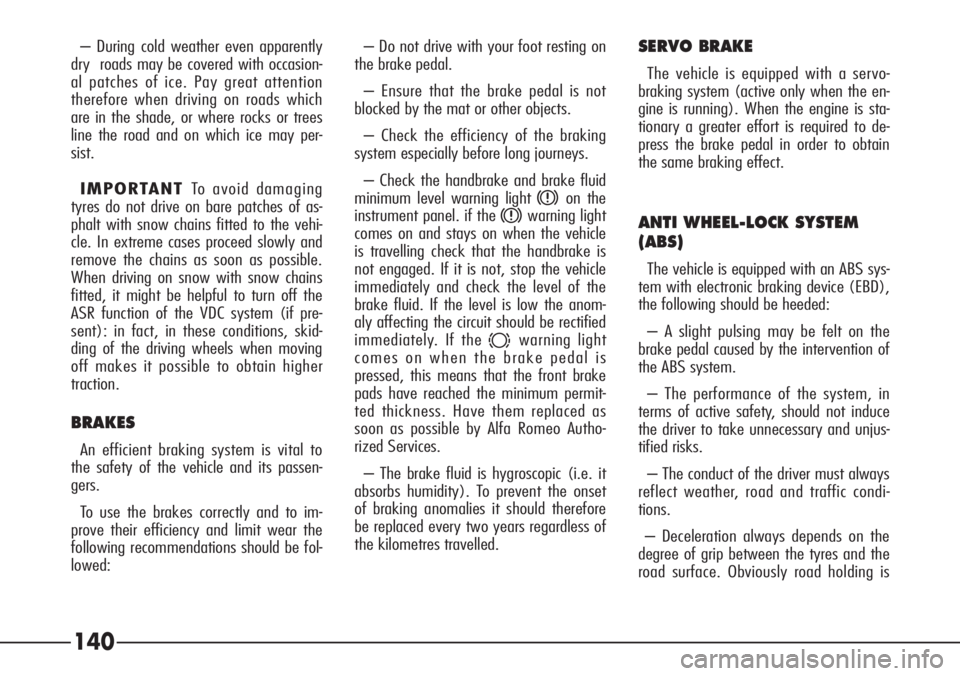
140
– During cold weather even apparently
dry roads may be covered with occasion-
al patches of ice. Pay great attention
therefore when driving on roads which
are in the shade, or where rocks or trees
line the road and on which ice may per-
sist.
IMPORTANT To avoid damaging
tyres do not drive on bare patches of as-
phalt with snow chains fitted to the vehi-
cle. In extreme cases proceed slowly and
remove the chains as soon as possible.
When driving on snow with snow chains
fitted, it might be helpful to turn off the
ASR function of the VDC system (if pre-
sent): in fact, in these conditions, skid-
ding of the driving wheels when moving
off makes it possible to obtain higher
traction.
BRAKES
An efficient braking system is vital to
the safety of the vehicle and its passen-
gers.
To use the brakes correctly and to im-
prove their efficiency and limit wear the
following recommendations should be fol-
lowed:– Do not drive with your foot resting on
the brake pedal.
– Ensure that the brake pedal is not
blocked by the mat or other objects.
– Check the efficiency of the braking
system especially before long journeys.
– Check the handbrake and brake fluid
minimum level warning light
xon the
instrument panel. if the
xwarning light
comes on and stays on when the vehicle
is travelling check that the handbrake is
not engaged. If it is not, stop the vehicle
immediately and check the level of the
brake fluid. If the level is low the anom-
aly affecting the circuit should be rectified
immediately. If the
dwarning light
comes on when the brake pedal is
pressed, this means that the front brake
pads have reached the minimum permit-
ted thickness. Have them replaced as
soon as possible by Alfa Romeo Autho-
rized Services.
– The brake fluid is hygroscopic (i.e. it
absorbs humidity). To prevent the onset
of braking anomalies it should therefore
be replaced every two years regardless of
the kilometres travelled.
SERVO BRAKE
The vehicle is equipped with a servo-
braking system (active only when the en-
gine is running). When the engine is sta-
tionary a greater effort is required to de-
press the brake pedal in order to obtain
the same braking effect.
ANTI WHEEL-LOCK SYSTEM
(ABS)
The vehicle is equipped with an ABS sys-
tem with electronic braking device (EBD),
the following should be heeded:
– A slight pulsing may be felt on the
brake pedal caused by the intervention of
the ABS system.
– The performance of the system, in
terms of active safety, should not induce
the driver to take unnecessary and unjus-
tified risks.
– The conduct of the driver must always
reflect weather, road and traffic condi-
tions.
– Deceleration always depends on the
degree of grip between the tyres and the
road surface. Obviously road holding is
Page 142 of 272
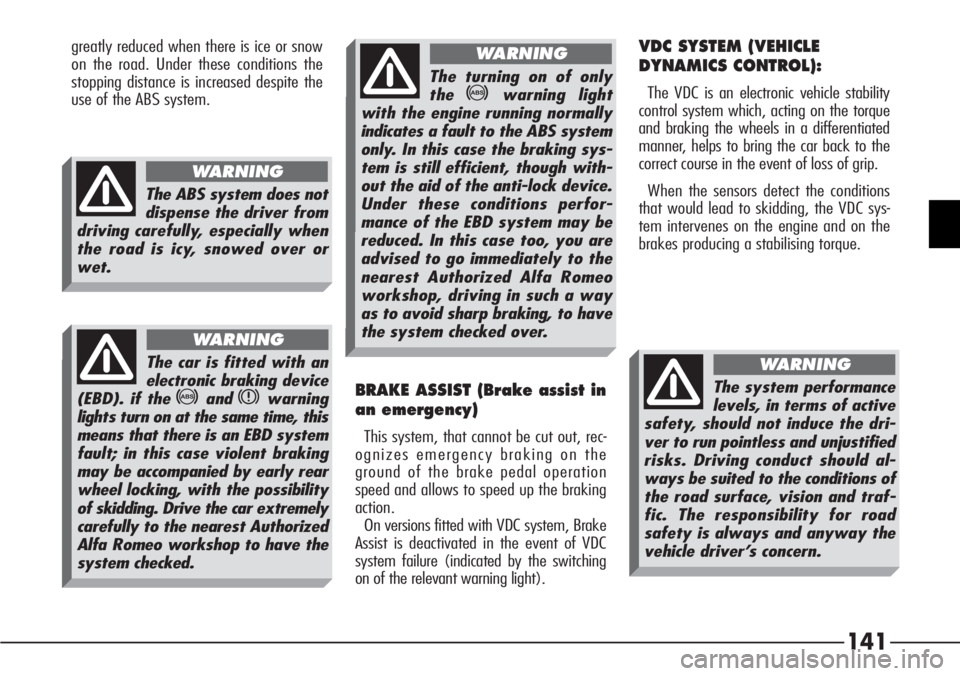
141
greatly reduced when there is ice or snow
on the road. Under these conditions the
stopping distance is increased despite the
use of the ABS system.VDC SYSTEM (VEHICLE
DYNAMICS CONTROL):
The VDC is an electronic vehicle stability
control system which, acting on the torque
and braking the wheels in a differentiated
manner, helps to bring the car back to the
correct course in the event of loss of grip.
When the sensors detect the conditions
that would lead to skidding, the VDC sys-
tem intervenes on the engine and on the
brakes producing a stabilising torque.
BRAKE ASSIST (Brake assist in
an emergency)
This system, that cannot be cut out, rec-
ognizes emergency braking on the
ground of the brake pedal operation
speed and allows to speed up the braking
action.
On versions fitted with VDC system, Brake
Assist is deactivated in the event of VDC
system failure (indicated by the switching
on of the relevant warning light).
The ABS system does not
dispense the driver from
driving carefully, especially when
the road is icy, snowed over or
wet.
WARNING
The car is fitted with an
electronic braking device
(EBD). if the
>andxwarning
lights turn on at the same time, this
means that there is an EBD system
fault; in this case violent braking
may be accompanied by early rear
wheel locking, with the possibility
of skidding. Drive the car extremely
carefully to the nearest Authorized
Alfa Romeo workshop to have the
system checked.
WARNING
The turning on of only
the
>warning light
with the engine running normally
indicates a fault to the ABS system
only. In this case the braking sys-
tem is still efficient, though with-
out the aid of the anti-lock device.
Under these conditions perfor-
mance of the EBD system may be
reduced. In this case too, you are
advised to go immediately to the
nearest Authorized Alfa Romeo
workshop, driving in such a way
as to avoid sharp braking, to have
the system checked over.
WARNING
The system performance
levels, in terms of active
safety, should not induce the dri-
ver to run pointless and unjustified
risks. Driving conduct should al-
ways be suited to the conditions of
the road surface, vision and traf-
fic. The responsibility for road
safety is always and anyway the
vehicle driver’s concern.
WARNING
Page 143 of 272
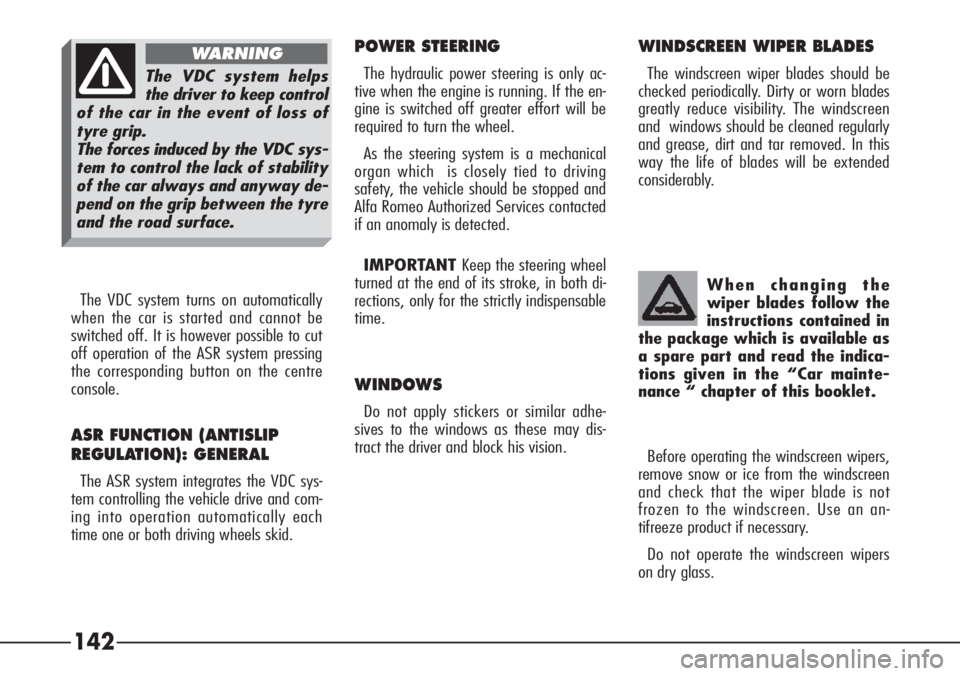
142
POWER STEERING
The hydraulic power steering is only ac-
tive when the engine is running. If the en-
gine is switched off greater effort will be
required to turn the wheel.
As the steering system is a mechanical
organ which is closely tied to driving
safety, the vehicle should be stopped and
Alfa Romeo Authorized Services contacted
if an anomaly is detected.
IMPORTANT Keep the steering wheel
turned at the end of its stroke, in both di-
rections, only for the strictly indispensable
time.
WINDOWS
Do not apply stickers or similar adhe-
sives to the windows as these may dis-
tract the driver and block his vision. The VDC system turns on automatically
when the car is started and cannot be
switched off. It is however possible to cut
off operation of the ASR system pressing
the corresponding button on the centre
console.
ASR FUNCTION (ANTISLIP
REGULATION): GENERAL
The ASR system integrates the VDC sys-
tem controlling the vehicle drive and com-
ing into operation automatically each
time one or both driving wheels skid.When changing the
wiper blades follow the
instructions contained in
the package which is available as
a spare part and read the indica-
tions given in the “Car mainte-
nance “ chapter of this booklet.
WINDSCREEN WIPER BLADES
The windscreen wiper blades should be
checked periodically. Dirty or worn blades
greatly reduce visibility. The windscreen
and windows should be cleaned regularly
and grease, dirt and tar removed. In this
way the life of blades will be extended
considerably.The VDC system helps
the driver to keep control
of the car in the event of loss of
tyre grip.
The forces induced by the VDC sys-
tem to control the lack of stability
of the car always and anyway de-
pend on the grip between the tyre
and the road surface.
WARNING
Before operating the windscreen wipers,
remove snow or ice from the windscreen
and check that the wiper blade is not
frozen to the windscreen. Use an an-
tifreeze product if necessary.
Do not operate the windscreen wipers
on dry glass.
Page 156 of 272
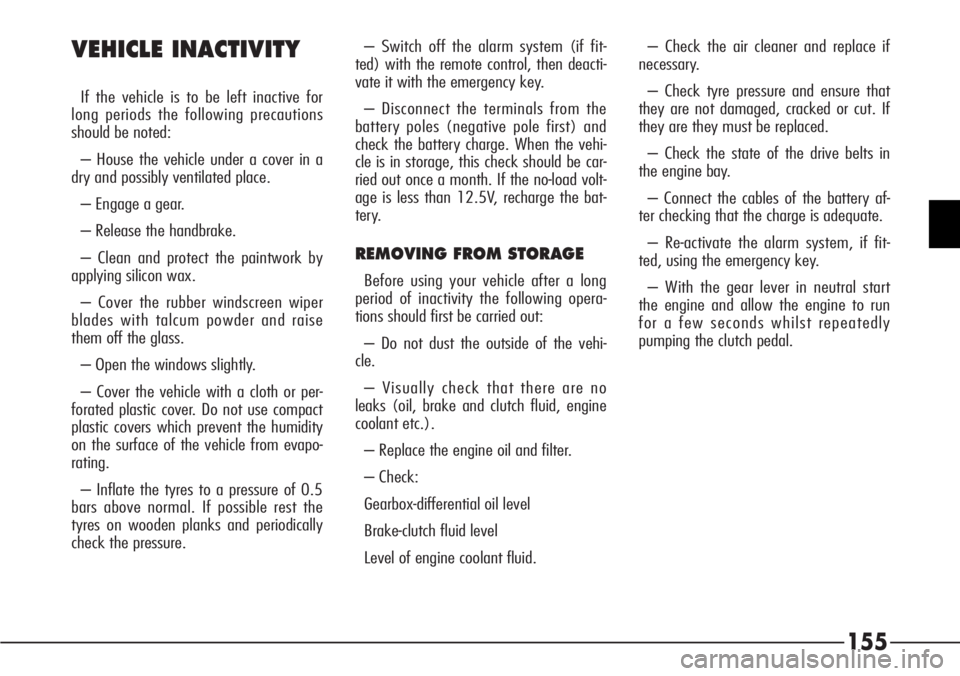
155 VEHICLE INACTIVITY
If the vehicle is to be left inactive for
long periods the following precautions
should be noted:
– House the vehicle under a cover in a
dry and possibly ventilated place.
– Engage a gear.
– Release the handbrake.
– Clean and protect the paintwork by
applying silicon wax.
– Cover the rubber windscreen wiper
blades with talcum powder and raise
them off the glass.
– Open the windows slightly.
– Cover the vehicle with a cloth or per-
forated plastic cover. Do not use compact
plastic covers which prevent the humidity
on the surface of the vehicle from evapo-
rating.
– Inflate the tyres to a pressure of 0.5
bars above normal. If possible rest the
tyres on wooden planks and periodically
check the pressure.– Switch off the alarm system (if fit-
ted) with the remote control, then deacti-
vate it with the emergency key.
– Disconnect the terminals from the
battery poles (negative pole first) and
check the battery charge. When the vehi-
cle is in storage, this check should be car-
ried out once a month. If the no-load volt-
age is less than 12.5V, recharge the bat-
tery.
REMOVING FROM STORAGE
Before using your vehicle after a long
period of inactivity the following opera-
tions should first be carried out:
– Do not dust the outside of the vehi-
cle.
– Visually check that there are no
leaks (oil, brake and clutch fluid, engine
coolant etc.).
– Replace the engine oil and filter.
– Check:
Gearbox-differential oil level
Brake-clutch fluid level
Level of engine coolant fluid.– Check the air cleaner and replace if
necessary.
– Check tyre pressure and ensure that
they are not damaged, cracked or cut. If
they are they must be replaced.
– Check the state of the drive belts in
the engine bay.
– Connect the cables of the battery af-
ter checking that the charge is adequate.
– Re-activate the alarm system, if fit-
ted, using the emergency key.
– With the gear lever in neutral start
the engine and allow the engine to run
for a few seconds whilst repeatedly
pumping the clutch pedal.
Page 203 of 272
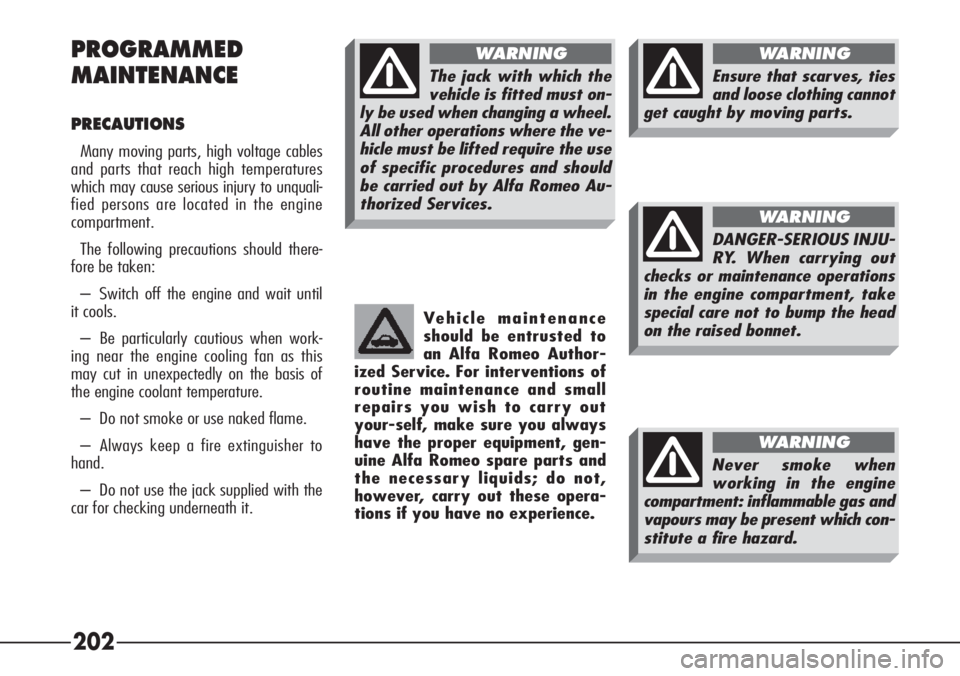
202 PROGRAMMED
MAINTENANCE
PRECAUTIONS
Many moving parts, high voltage cables
and parts that reach high temperatures
which may cause serious injury to unquali-
fied persons are located in the engine
compartment.
The following precautions should there-
fore be taken:
– Switch off the engine and wait until
it cools.
– Be particularly cautious when work-
ing near the engine cooling fan as this
may cut in unexpectedly on the basis of
the engine coolant temperature.
– Do not smoke or use naked flame.
– Always keep a fire extinguisher to
hand.
– Do not use the jack supplied with the
car for checking underneath it.Vehicle maintenance
should be entrusted to
an Alfa Romeo Author-
ized Service. For interventions of
routine maintenance and small
repairs you wish to carry out
your-self, make sure you always
have the proper equipment, gen-
uine Alfa Romeo spare parts and
the necessary liquids; do not,
however, carry out these opera-
tions if you have no experience.
The jack with which the
vehicle is fitted must on-
ly be used when changing a wheel.
All other operations where the ve-
hicle must be lifted require the use
of specific procedures and should
be carried out by Alfa Romeo Au-
thorized Services.
WARNING
Ensure that scarves, ties
and loose clothing cannot
get caught by moving parts.
WARNING
DANGER-SERIOUS INJU-
RY. When carrying out
checks or maintenance operations
in the engine compartment, take
special care not to bump the head
on the raised bonnet.
WARNING
Never smoke when
working in the engine
compartment: inflammable gas and
vapours may be present which con-
stitute a fire hazard.
WARNING
Page 205 of 272
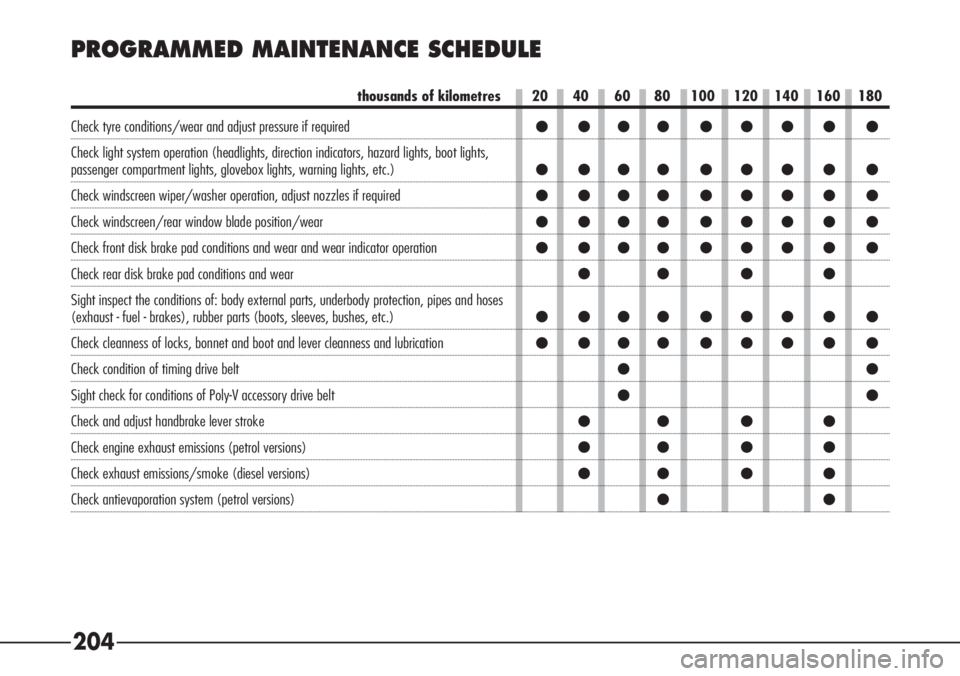
204
PROGRAMMED MAINTENANCE SCHEDULE
thousands of kilometres
Check tyre conditions/wear and adjust pressure if required
Check light system operation (headlights, direction indicators, hazard lights, boot lights,
passenger compartment lights, glovebox lights, warning lights, etc.)
Check windscreen wiper/washer operation, adjust nozzles if required
Check windscreen/rear window blade position/wear
Check front disk brake pad conditions and wear and wear indicator operation
Check rear disk brake pad conditions and wear
Sight inspect the conditions of: body external parts, underbody protection, pipes and hoses
(exhaust - fuel - brakes), rubber parts (boots, sleeves, bushes, etc.)
Check cleanness of locks, bonnet and boot and lever cleanness and lubrication
Check condition of timing drive belt
Sight check for conditions of Poly-V accessory drive belt
Check and adjust handbrake lever stroke
Check engine exhaust emissions (petrol versions)
Check exhaust emissions/smoke (diesel versions)
Check antievaporation system (petrol versions)20 40 60 80 100 120 140 160 180
● ●●● ● ● ● ● ●
● ●●● ● ● ● ● ●
● ●●● ● ● ● ● ●
● ●●● ● ● ● ● ●
● ●●● ● ● ● ● ●
●● ● ●
● ●●● ● ● ● ● ●
● ●●● ● ● ● ● ●
●●
●●
●● ● ●
●● ● ●
●● ● ●
●●
Page 206 of 272
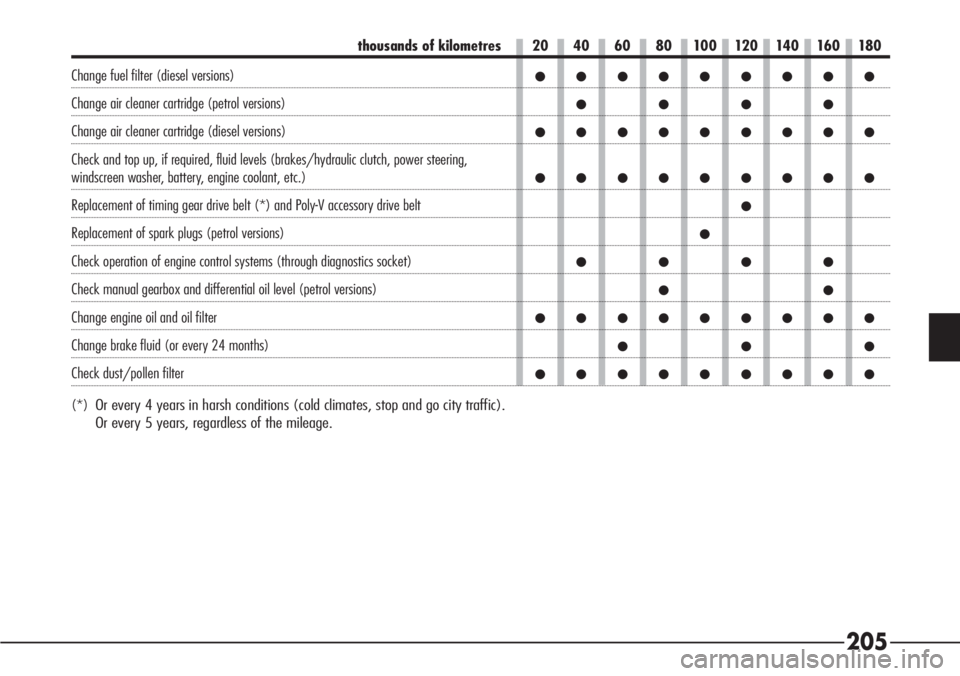
205
thousands of kilometres 20 40 60 80 100 120 140 160 180
Change fuel filter (diesel versions)•••••••••
Change air cleaner cartridge (petrol versions)••••
Change air cleaner cartridge (diesel versions)•••••••••
Check and top up, if required, fluid levels (brakes/hydraulic clutch, power steering,
windscreen washer, battery, engine coolant, etc.)•••••••••
Replacement of timing gear drive belt (*) and Poly-V accessory drive belt•
Replacement of spark plugs (petrol versions)•
Check operation of engine control systems (through diagnostics socket)••••
Check manual gearbox and differential oil level (petrol versions)••
Change engine oil and oil filter •••••••••
Change brake fluid (or every 24 months)•••
Check dust/pollen filter•••••••••
(*)Or every 4 years in harsh conditions (cold climates, stop and go city traffic).
Or every 5 years, regardless of the mileage.
Page 207 of 272
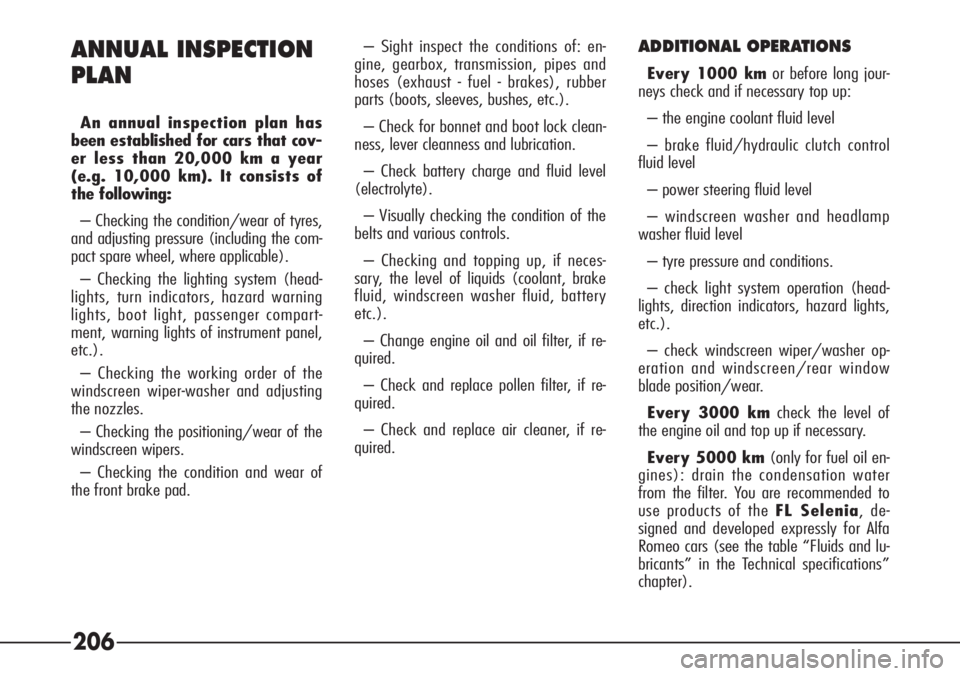
206 ANNUAL INSPECTION
PLAN
An annual inspection plan has
been established for cars that cov-
er less than 20,000 km a year
(e.g. 10,000 km). It consists of
the following:
– Checking the condition/wear of tyres,
and adjusting pressure (including the com-
pact spare wheel, where applicable).
– Checking the lighting system (head-
lights, turn indicators, hazard warning
lights, boot light, passenger compart-
ment, warning lights of instrument panel,
etc.).
– Checking the working order of the
windscreen wiper-washer and adjusting
the nozzles.
– Checking the positioning/wear of the
windscreen wipers.
– Checking the condition and wear of
the front brake pad.– Sight inspect the conditions of: en-
gine, gearbox, transmission, pipes and
hoses (exhaust - fuel - brakes), rubber
parts (boots, sleeves, bushes, etc.).
– Check for bonnet and boot lock clean-
ness, lever cleanness and lubrication.
– Check battery charge and fluid level
(electrolyte).
– Visually checking the condition of the
belts and various controls.
– Checking and topping up, if neces-
sary, the level of liquids (coolant, brake
fluid, windscreen washer fluid, battery
etc.).
– Change engine oil and oil filter, if re-
quired.
– Check and replace pollen filter, if re-
quired.
– Check and replace air cleaner, if re-
quired.
ADDITIONAL OPERATIONS
Every 1000 kmor before long jour-
neys check and if necessary top up:
– the engine coolant fluid level
– brake fluid/hydraulic clutch control
fluid level
– power steering fluid level
– windscreen washer and headlamp
washer fluid level
– tyre pressure and conditions.
– check light system operation (head-
lights, direction indicators, hazard lights,
etc.).
– check windscreen wiper/washer op-
eration and windscreen/rear window
blade position/wear.
Every 3000 kmcheck the level of
the engine oil and top up if necessary.
Every 5000 km(only for fuel oil en-
gines): drain the condensation water
from the filter. You are recommended to
use products of the FL Selenia, de-
signed and developed expressly for Alfa
Romeo cars (see the table “Fluids and lu-
bricants” in the Technical specifications”
chapter).
Page 208 of 272
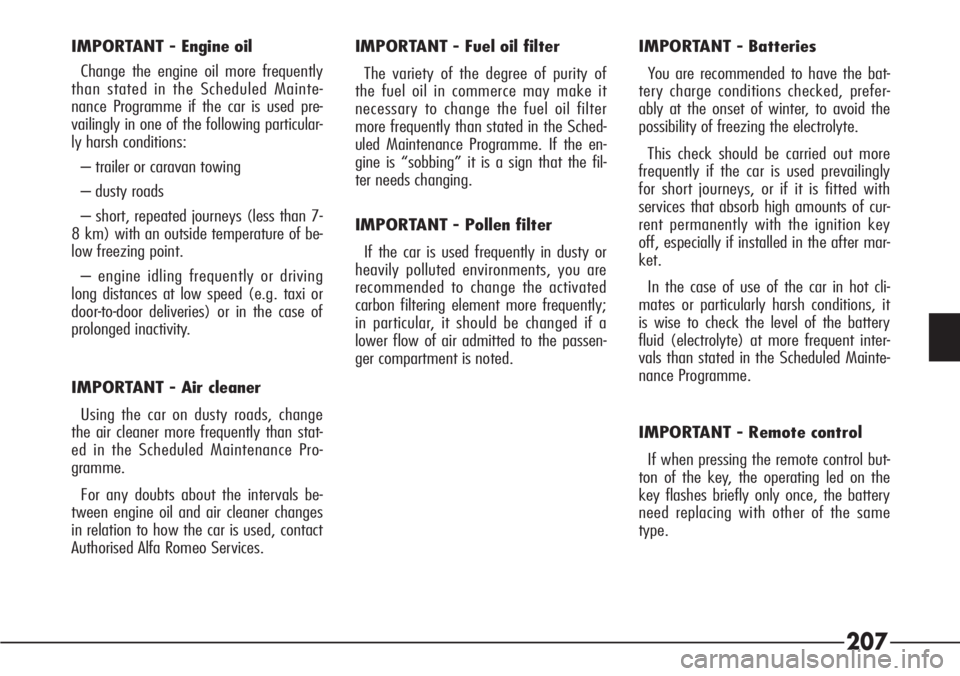
207
IMPORTANT - Engine oil
Change the engine oil more frequently
than stated in the Scheduled Mainte-
nance Programme if the car is used pre-
vailingly in one of the following particular-
ly harsh conditions:
– trailer or caravan towing
– dusty roads
– short, repeated journeys (less than 7-
8 km) with an outside temperature of be-
low freezing point.
– engine idling frequently or driving
long distances at low speed (e.g. taxi or
door-to-door deliveries) or in the case of
prolonged inactivity.
IMPORTANT - Air cleaner
Using the car on dusty roads, change
the air cleaner more frequently than stat-
ed in the Scheduled Maintenance Pro-
gramme.
For any doubts about the intervals be-
tween engine oil and air cleaner changes
in relation to how the car is used, contact
Authorised Alfa Romeo Services.IMPORTANT - Fuel oil filter
The variety of the degree of purity of
the fuel oil in commerce may make it
necessary to change the fuel oil filter
more frequently than stated in the Sched-
uled Maintenance Programme. If the en-
gine is “sobbing” it is a sign that the fil-
ter needs changing.
IMPORTANT - Pollen filter
If the car is used frequently in dusty or
heavily polluted environments, you are
recommended to change the activated
carbon filtering element more frequently;
in particular, it should be changed if a
lower flow of air admitted to the passen-
ger compartment is noted.IMPORTANT - Batteries
You are recommended to have the bat-
tery charge conditions checked, prefer-
ably at the onset of winter, to avoid the
possibility of freezing the electrolyte.
This check should be carried out more
frequently if the car is used prevailingly
for short journeys, or if it is fitted with
services that absorb high amounts of cur-
rent permanently with the ignition key
off, especially if installed in the after mar-
ket.
In the case of use of the car in hot cli-
mates or particularly harsh conditions, it
is wise to check the level of the battery
fluid (electrolyte) at more frequent inter-
vals than stated in the Scheduled Mainte-
nance Programme.
IMPORTANT - Remote control
If when pressing the remote control but-
ton of the key, the operating led on the
key flashes briefly only once, the battery
need replacing with other of the same
type.
Page 210 of 272
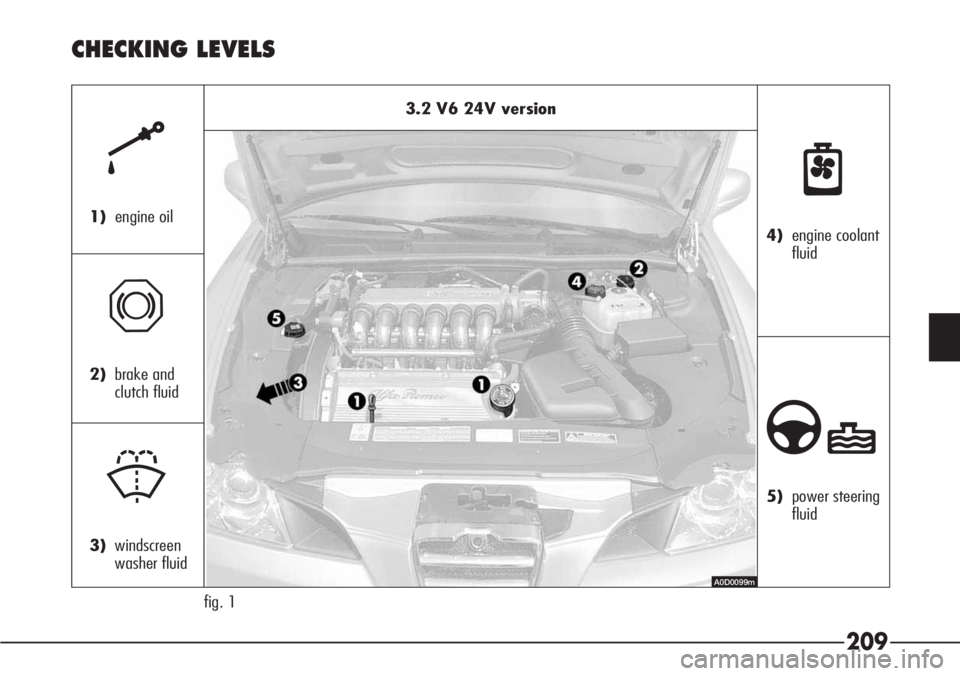
209
3.2 V6 24V version
fig. 1
k
1)engine oil
π
2)brake and
clutch fluid
+
3)windscreen
washer fluid
n
4)engine coolant
fluid
∂
5)power steering
fluid
A0D0099m
CHECKING LEVELS